人教版高中英语必修一Unit3 Journey Down The Mekong教案
- 格式:pdf
- 大小:1.27 MB
- 文档页数:7
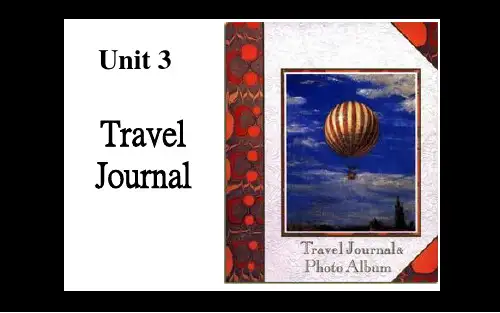
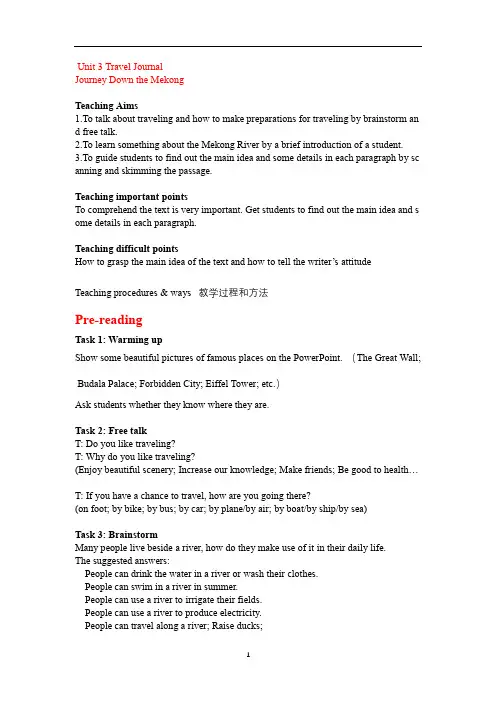
Unit3Travel JournalJourney Down the MekongTeaching Aims1.To talk about traveling and how to make preparations for traveling by brainstorm and free talk.2.To learn something about the Mekong River by a brief introduction of a student.3.To guide students to find out the main idea and some details in each paragraph by sc anning and skimming the passage.Teaching important pointsTo comprehend the text is very important.Get students to find out the main idea and s ome details in each paragraph.Teaching difficult pointsHow to grasp the main idea of the text and how to tell the writer’s attitude Teaching procedures&ways教学过程和方法Pre-readingTask1: Warming upShow some beautiful pictures of famous places on the PowerPoint.(The Great Wall; Budala Palace;Forbidden City;Eiffel Tower;etc.)Ask students whether they know where they are.Task2: Free talkT:Do you like traveling?T:Why do you like traveling?(Enjoy beautiful scenery;Increase our knowledge;Make friends;Be good to health…T: If you have a chance to travel,how are you going there?(on foot;by bike;by bus;by car;by plane/by air;by boat/by ship/by sea)Task3:BrainstormMany people live beside a river,how do they make use of it in their daily life.The suggested answers:People can drink the water in a river or wash their clothes.People can swim in a river in summer.People can use a river to irrigate their fields.People can use a river to produce electricity.People can travel along a river; Raise ducks;While-readingThere are many great rivers in the world. Have you ever dreamed about travelling along one of them? Today we will follow Wang Kun and Wang Wei to travel along the Chinese part of Mekong River.Task 1 One student will introduce the Mekong River.Task 2 Co-operation study,After listening, skim the passage and find out the answers to the following questions para by para.Para.11. What was Wang Kun and Wang Wei’s idea of a good trip?2. What is the Chinese part of Mekong River?3. Who planned the trip to the Mekong?Para.21. Did Wang Wei know the best way of getting to places?2. Who insisted on organizing the trip? Why?3. What’s Wang Wei’s attitude to the trip?4. What’s Wang Kun’s attitude to the trip?Para.31. Where is the source of the Mekong and which sea does it end?2. Translate the following sentence in Chinese.It makes wide bends or meanders through low valleys to the plains where rice grows.Task 3Co-operation study fill in blanks with the help of illustrationsThe Mekong River is called _____________ in China. It goes through ____________ _____, _________, _________, _________ and pours into the ________________.Wang Kun and ___ _____ Wang Wei are dreaming about ____________________. They have the idea to _____ ______ the Mekong River from ______ it ______ to ______ it _____.It begins in a _______ on a ________ _________. Then, it ______ quickly. It becomes______ as it passes through deep ______.Sometimes, the river becomes a ________ and enters ____ ________.At last, the river _____ enters the South China Sea.Post-reading:DiscussionIn groups of four, summarize the main idea of the passage and tell why.(The passage tells us a main idea that no success in life merely happens by describing my sister’s and my dream---taking a bike trip and preparations for the trip.) Homework:Imagine that you are Wang Wei, tell your classmates your experiences about your traveling, and write it down.。
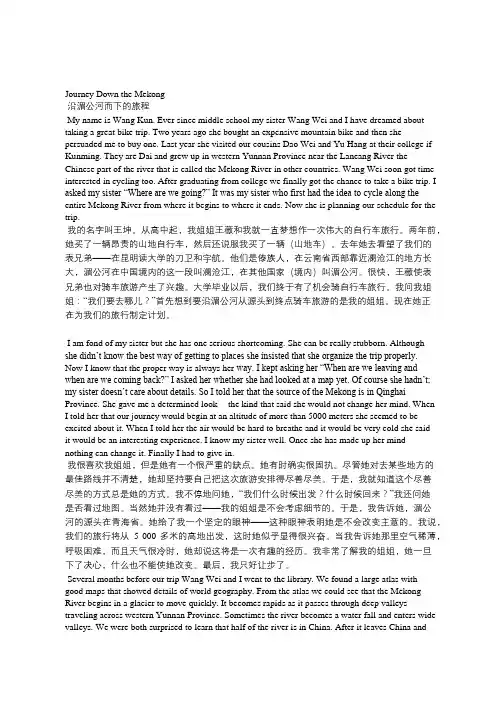
Journey Down the Mekong沿湄公河而下的旅程My name is Wang Kun. Ever since middle school my sister Wang Wei and I have dreamed about taking a great bike trip. Two years ago she bought an expensive mountain bike and then she persuaded me to buy one. Last year she visited our cousins Dao Wei and Yu Hang at their college if Kunming. They are Dai and grew up in western Yunnan Province near the Lancang River the Chinese part of the river that is called the Mekong River in other countries. Wang Wei soon got time interested in cycling too. After graduating from college we finally got the chance to take a bike trip. I asked my sister “Where are we going?” It was my sister who first had the idea to cycle along the entire Mekong River from where it begins to where it ends. Now she is planning our schedule for the trip.我的名字叫王坤。
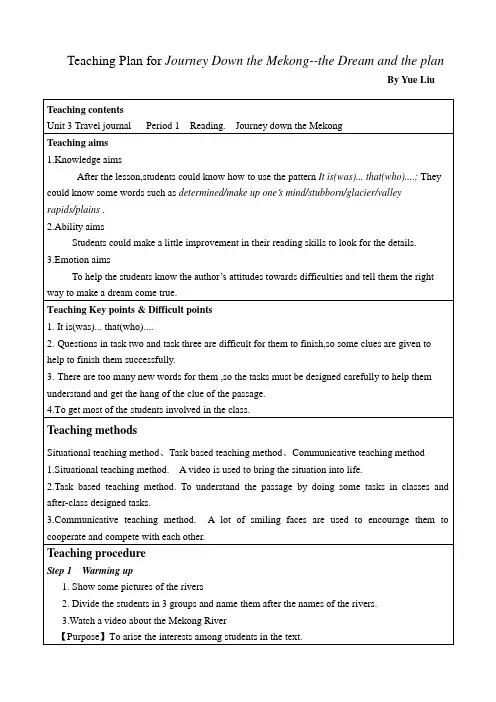
Teaching Plan for Journey Down the Mekong--the Dream and the planBy Yue LiuTeaching contentsUnit 3 Travel journal Period 1 Reading. Journey down the MekongTeaching aims1.Knowledge aimsAfter the lesson,students could know how to use the pattern It is(was)... that(who)....; They could know some words such as determined/make up one’s mind/stubborn/glacier/valleyrapids/plains .2.Ability aimsStudents could make a little improvement in their reading skills to look for the details.3.Emotion aimsTo help the students know the author’s attitude s towards difficulties and tell them the right way to make a dream come true.Teaching Key points & Difficult points1. It is(was)... that(who)....2.Questions in task two and task three are difficult for them to finish,so some clues are given to help to finish them successfully.3.There are too many new words for them ,so the tasks must be designed carefully to help them understand and get the hang of the clue of the passage.4.To get most of the students involved in the class.Teaching methodsSituational teaching method、Task based teaching method、Communicative teaching method1.Situational teaching method. A video is used to bring the situation into life.2.Task based teaching method. To understand the passage by doing some tasks in classes and after-class designed tasks.municative teaching method. A lot of smiling faces are used to encourage them to cooperate and compete with each other.Teaching procedureStep 1 Warming up1. Show some pictures of the rivers2. Divide the students in 3 groups and name them after the names of the rivers.3.Watch a video about the Mekong River【Purpose】To arise the interests among students in the text.Step 2 While-reading Read the passage and finish four tasks.Task one Read Para.1 and find the answers to the following questions1.Who are Wang Kun and Wang Wei?2.What was their dream?3.Who planned the trip first and what ’s their plan?Task one plus Use emphatic sentence to stress the underlined partThe pattern It is (was) 被强调部分+ that (who) + 句子其他部分.1.Two years ago she bought an expensive mountain bike.2.Two years ago she bought an expensive mountain bike.3.Two years ago she bought an expensive mountain bike.Task two Read Para. 2 and fill in the blanks1.Can you find out two adjectives to describe Wang Wei ’s character?_______ _________2.What difficulties did Wang Wei and Wang Kun find about their journey?And what were Wang Wei ’s attitudes?Difficulties AttitudesTask three Read Para.3 and fill in the blanks1.Facing difficulties,what did they do ?Several months before our trip,Wang Wei and I______________ and found ________with ____________.2.What could they see from the atlas?glacier【Purpose 】To improve students’ skills in looking for details and make students apply reading strategies to get some information.Step 3 Post-reading Check the answers and do some summariesDream Difficulties & Attitudes PlanFree talk . Everyone has a big dream, but how to make it come true?We should __________________________Once we have_________________________,nothing can change it.We should_______________________________________________It is ______________ that plays an important role in making a dream come true.Where there is a will,there is away(有志者,事竟成).【Purpose 】To help students get a deep understanding of the passage and achieve the emotional aims.Step 4 Homework1.Write a short passage about how to make a dream come true.2. Preview the part 2 of journey down the Mekong .【Purpose 】To consolidate and enhance the knowledge that we learn from this class and get ready for the next class.The _________ is in ______province! The ____ is more than _____meters. It would be hard to _________ It’s very ______ . A ______________ lookBe_____________about it An _________ experience。

Unit 3 Travel JournalReadingJOURNEY DOWN THE MEKONG▲三维目标Knowledge Aims:1. Get students to summarize and remember the main idea of thepassage — Journey down the Mekong.2. Let students know more about the Mekong River.Ability Aims:1. Enable students to learn to talk about trip.2. Develop students’ reading ability and let them learn different.reading skills.Emotional Aims:1. Arouse students’ great interest in the Mekong River.2. Develop students’ sense of cooperative learning.▲Teaching Important Points1. Let students learn more about the Mekong River.2. Get students to learn different reading skills.▲Teaching Difficult Points1. Develop students’ reading ability.2. Enable students to learn more about the Mekong River. ▲Teaching Methods1. Task-based teaching and learning2. Cooperative learning.3. Discussion.4. Skimming5. Scanning▲Teaching AidsMulti-media and other normal teaching tools.▲Teaching ProceduresStep I: Revision1.Words Reviewvt. 说服;劝说persuadevi. 骑自行车cyclevi. 毕业n. 大学毕业生graduateadv. 最后;终于finallyn. 时间表;进度表schedulevt. 为某事安排时间adj. 喜爱的;慈爱的;宠爱的fondn. 缺点shortcoming stubborn adj. 顽固的;固执的organize vt. 组织;成立detail n. 细节;详情source n. 来源;水源determine vt. 决定;确定;下定决心determined adj. 坚决的;有决心的\ journey n. 旅行;旅程altitude n. 海拔高度;高处n. 地图;地图集atlasn. 冰河;冰川glaciern. 急流rapidsn.(山)谷;流域valleyn. 瀑布waterfallvi. 缓慢而行;踱步pacen. 一步;速度;步调n. 弯;拐角bendvt. 使弯曲vi. 弯身;弯腰2.Match 改变主意ever since 下决心; 决定be fond of 投降; 屈服; 让步care about 从那以后change one’s mind喜爱; 喜欢give in 关心; 忧虑; 惦念make up one’s mind照顾; 照看Step II. Pre-readingWhere is the Mekong River? Find the countries that the Mekong River flows through.The Mekong RiverChinaMyanmar LaosVietnamThailand Cambodia Step III. Reading1.Scanning (for specific information)(1) Read paragraph 1 quickly and finish the exercise (Fast reading)How will Wang Kun and Wang Wei travel along the Mekong River?A. On foot.B. By car.C. By bicycle.D. By ship.(2) Read paragraph 2 carefully and finish the exercise (Pair work)Which sentence is NOT true according to the text?A. Wang Wei advised Wang Kun to buy a mountain bike and he agreed.B. Wang Wei seldom listened to others.C. Before their trip they went to the library.D. Wang Wei knew the best way of getting to places.(3) Read paragraph 3 carefully and finish the exercise (Discuss the question in groups)True or false and give a reason.1. They couldn’t find any information about the Mekong River in the library.2. The Mekong river begins in a glacier on a Tibetan mountain, the water there is clear and warm.3. The river delta enters the South China Sea.2.Skimming( for general idea)(1) Match the main ideas with the paragraphs.Para. 1: Wang Wei insisted on finding the sourceof river and beginning their journey there. Para. 2: From the atlas, they learned a lotabout the Mekong River.Para. 3: The writer and his sister finallygot a chance to take a great trip.(2)What is the main idea of the text?A. A brief introduction to the Mekong River.B. Some tips on how to travel along the Mekong River.C. Wang Kun and Wang Wei’s plan for their summer holidays.D. Wang Kun and Wang Wei’s plan and preparations for their trip along the Mekong River.(3)Try to retell the passage (try to fill in the blank and retell the passage)Step Ⅳ. Homework1.Write a travel journal or plan in about 100 words.2.发挥想象,连词成文(50-100字)。


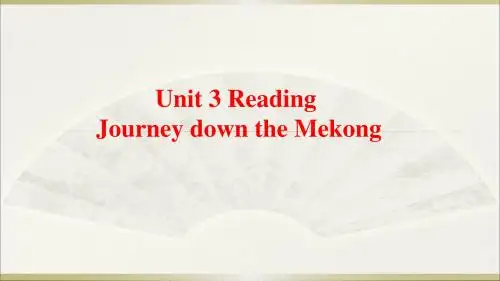
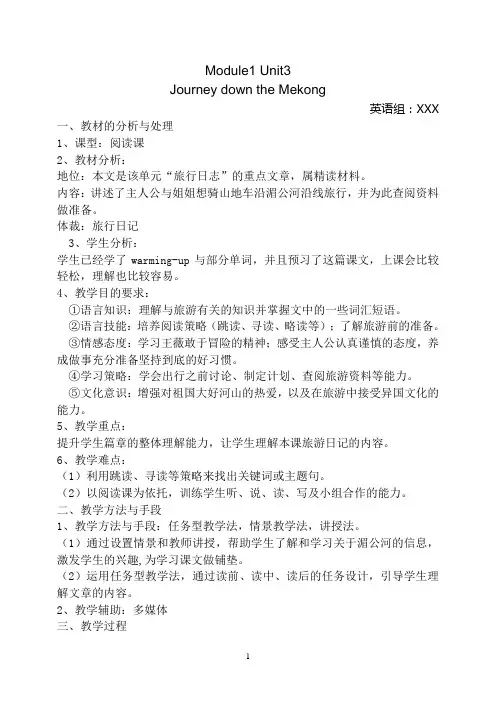
Module1 Unit3Journey down the Mekong英语组:XXX一、教材的分析与处理1、课型:阅读课2、教材分析:地位:本文是该单元“旅行日志”的重点文章,属精读材料。
内容:讲述了主人公与姐姐想骑山地车沿湄公河沿线旅行,并为此查阅资料做准备。
体裁:旅行日记3、学生分析:学生已经学了warming-up与部分单词,并且预习了这篇课文,上课会比较轻松,理解也比较容易。
4、教学目的要求:①语言知识:理解与旅游有关的知识并掌握文中的一些词汇短语。
②语言技能:培养阅读策略(跳读、寻读、略读等);了解旅游前的准备。
③情感态度:学习王薇敢于冒险的精神;感受主人公认真谨慎的态度,养成做事充分准备坚持到底的好习惯。
④学习策略:学会出行之前讨论、制定计划、查阅旅游资料等能力。
⑤文化意识:增强对祖国大好河山的热爱,以及在旅游中接受异国文化的能力。
5、教学重点:提升学生篇章的整体理解能力,让学生理解本课旅游日记的内容。
6、教学难点:(1)利用跳读、寻读等策略来找出关键词或主题句。
(2)以阅读课为依托,训练学生听、说、读、写及小组合作的能力。
二、教学方法与手段1、教学方法与手段:任务型教学法,情景教学法,讲授法。
(1)通过设置情景和教师讲授,帮助学生了解和学习关于湄公河的信息,激发学生的兴趣,为学习课文做铺垫。
(2)运用任务型教学法,通过读前、读中、读后的任务设计,引导学生理解文章的内容。
2、教学辅助:多媒体三、教学过程Step1: Lead inAsk some students to present their dialogue.(The homework of last class)【设计说明】采用对话形式导入,营造出宽松的学习气氛,为学生全面的课堂参与作了铺垫。
Step2: Pre-readingShow students some pictures and maps to know more about the Mekong river, its two names and the route it flows out of China.1. Names: Lancang River and Mekong River2. Route: China-Myanmar-Laos-Thailand-Cambodia-Vietnam-South China sea 【设计说明】利用图片来了解湄公河,为课文第三段做铺垫,同时,激发了学生的兴趣和好奇心。

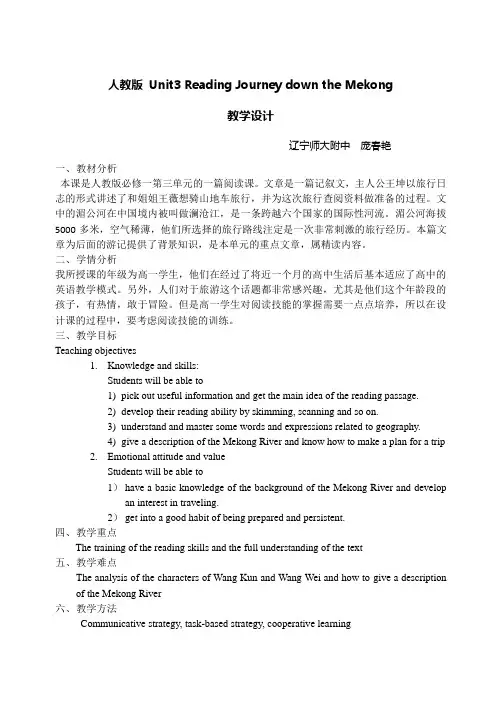
人教版Unit3 Reading Journey down the Mekong教学设计辽宁师大附中庞春艳一、教材分析本课是人教版必修一第三单元的一篇阅读课。
文章是一篇记叙文,主人公王坤以旅行日志的形式讲述了和姐姐王薇想骑山地车旅行,并为这次旅行查阅资料做准备的过程。
文中的湄公河在中国境内被叫做澜沧江,是一条跨越六个国家的国际性河流。
湄公河海拔5000多米,空气稀薄,他们所选择的旅行路线注定是一次非常刺激的旅行经历。
本篇文章为后面的游记提供了背景知识,是本单元的重点文章,属精读内容。
二、学情分析我所授课的年级为高一学生,他们在经过了将近一个月的高中生活后基本适应了高中的英语教学模式。
另外,人们对于旅游这个话题都非常感兴趣,尤其是他们这个年龄段的孩子,有热情,敢于冒险。
但是高一学生对阅读技能的掌握需要一点点培养,所以在设计课的过程中,要考虑阅读技能的训练。
三、教学目标Teaching objectives1.Knowledge and skills:Students will be able to1)pick out useful information and get the main idea of the reading passage.2)develop their reading ability by skimming, scanning and so on.3)understand and master some words and expressions related to geography.4)give a description of the Mekong River and know how to make a plan for a trip2.Emotional attitude and valueStudents will be able to1)have a basic knowledge of the background of the Mekong River and develop an interest in traveling.2)get into a good habit of being prepared and persistent.四、教学重点The training of the reading skills and the full understanding of the text五、教学难点The analysis of the characters of Wang Kun and Wang Wei and how to give a description of the Mekong River六、教学方法Communicative strategy, task-based strategy, cooperative learning七、教学过程【体现教学目标达成、教学重难点突破、教法学法说明】八、 板书设计。